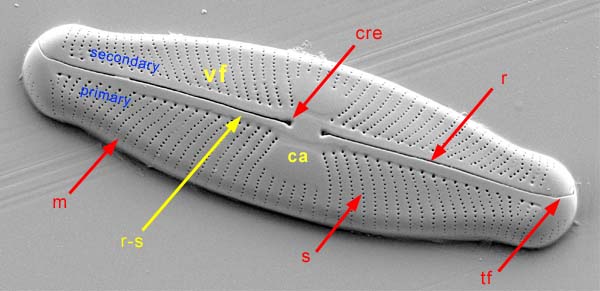Overall organization of the valve in Sellaphora
The valves of Sellaphora species all have the same basic structure.
Each valve is like a shallow, flat-bottomed, boat-like dish. Here the valve is seen from the outside, so that the dish appears upside-down. It consists of a flat 'valve-face' (vf) and a downturned edge, the 'mantle' (m). The outline of the valve varies among Sellaphora species, from a simple ellipse to almost rectangular to the elongate-lemon shape shown here. Outline shape is important for identifying species, but it varies considerably during the life-cycle; it is even more variable in laboratory cultures than in the natural populations from which the cultures were obtained.
The structure of the valve is basically feather-like, with a longitudinal axis bearing lateral projections. This is why such diatoms are called 'pennate' (Latin pinna, penna). The structure is also reminiscent of the human rib-cage and because of this, the flattened or rib-like longitudinal axis (r-s) – equivalent to the feather's rachis – is referred to as the 'sternum'. In Sellaphora, the sternum contains two raphe-slits (r) along its centre and so it is referred to as a 'raphe-sternum'. On each side of the raphe-sternum, ribs of silica extend out towards the margin, separated by the 'striae' (s), which are lines of simple round pores (double lines in S. seminulum). The spacing of the striae varies among Sellaphora species and is important for identification. At the centre, where there is a break between the two raphe-slits, there is a clear area of the valve face that is devoid of striae; this central area (ca) varies in shape and size between different Sellaphora species.
At first sight, the valve appears to be biltareally symmetrical. However, it develops asynchronously: one side is initiated before the other, primary before secondary. Subtle asymmetries allow the primary and secondary sides to be distinguished even after valve formation is complete. For example, the terminal fissures (tf) of the raphe slits bend towards the secondary side at the poles, and the external central raphe endings (cre) are turned slightly towards the primary side.
Further information is given by Mann (1989) and Round et al. (1990).


 This site is hosted by the Royal Botanic
Garden Edinburgh.
This site is hosted by the Royal Botanic
Garden Edinburgh.